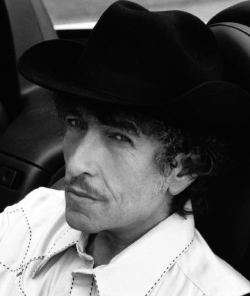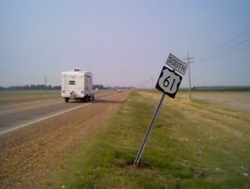 June 07
June 07
He’s Not There (2007): Talkin’ Bob Dylan Symposium Blues
Stephen Hazan Arnoff
 A group of some one hundred and fifty scholars, writers, musicians, critics, and other careful listeners came to Highway 61 Revisited: Dylan’s Road from Minnesota to the World at the University of Minnesota this past March looking for a cure for their Talkin’ Bob Dylan Blues. With more than fifty papers presented over three days on topics including (but not limited to) Dylan and the disabled, sleaze, Japan and England and Italy, Andy Warhol, Zen, trains, Virgil, the Nobel Prize, his fans, and the apocalypse, it was a chance for some of the artist’s most faithful interpreters to try to craft something beautiful or useful or dissonant or inspiring from thinking about Dylan’s work from just about every conceivable angle.
A group of some one hundred and fifty scholars, writers, musicians, critics, and other careful listeners came to Highway 61 Revisited: Dylan’s Road from Minnesota to the World at the University of Minnesota this past March looking for a cure for their Talkin’ Bob Dylan Blues. With more than fifty papers presented over three days on topics including (but not limited to) Dylan and the disabled, sleaze, Japan and England and Italy, Andy Warhol, Zen, trains, Virgil, the Nobel Prize, his fans, and the apocalypse, it was a chance for some of the artist’s most faithful interpreters to try to craft something beautiful or useful or dissonant or inspiring from thinking about Dylan’s work from just about every conceivable angle.
Musician Spider John Koerner started the program by pointing out the irony of the impending explosion of Dylan Talk in the land of the typically laconic Minnesotan, joking: “Did you hear the one about the Norwegian who loved his wife so much he almost told her?” Then conference organizer Colleen Sheehy noted that regardless of any Nordic reserve in the air, all of the participants shared a burden for which she was quite grateful: “We can’t stop talking about him,” she said.
In our defense, Dylan is as ubiquitous as ever, and there is a lot to talk about. Tune in to Theme Time Radio Hour, and for just $12.95 a month (yes friends, that’s just $12.95 a month – satellite radio receiver not included), host Bob Dylan will talk your ear off every week, a freewheelin’, genial, and even giddy host introducing and parsing a thematic grab bag of country, soul, rock, and blues. Hear the Yoda of DJs declaiming excerpts from Paradise Lost or a poem by Emily Dickenson, singing “Take Me Out to the Ballgame” a capella, answering (probably fake) email correspondence from listeners, preaching about the Bible or Women’s Names or Laughter, sharing recipes for drinks, or rattling off forty or so names of favorite flowers, including the name of one – the Victoria Sorgum – that he invents on the spot, cracking himself up on air. Though he does not address the audience directly, Dylan performs incessantly – upwards of one hundred concerts a year at county fairs, private corporate events, casinos, festivals, zoos, and mid- and large-size halls, even spending a few summers with Willie Nelson appearing only in minor league baseball parks. Having recently shared his visage with an ad campaign by Victoria’s Secret, published the first segment of a multi-volume memoir, produced a documentary on his early career with Martin Scorsese, and green lighted a bio-pic entitled I’m Not There (featuring not one, but seven actors in the role of you-know-who), when it comes to the public sphere, Bob Dylan can’t stop talking either.
Ain’t Talkin’
Expecting a symposium of “talks” to glean a deep sense of Dylan Talk is a tall order. Consider the stubborn claims of “Ain't Talkin'” from last year’s album Modern Times: Here a cantankerous, downhearted narrator voices resignation about the fact that there is nothing at all left to talk about in the world, let alone him; all that remains is to ramble. “Ain’t talking, just walkin’,” Dylan’s narrator says – a wandering Jew par excellence, a drifter, a runaway slave.
Like the curse of the biblical Cain himself, the curse of the hero of “Ain’t Talkin’” – as well as the majority of Dylan’s songs from Time Out of Mind (1997), Love and Theft (2001) and Modern Times (2006) – carries the burden of what might otherwise be considered twin blessings: difference and survival. And while Dylan’s hero in “Ain’t Talkin’” and its companion songs is set apart by having nothing left to lose, he also never has the security to sleep in the same bed twice:
Ain't talkin', just walkin'
Through this weary world of woe
Heart burnin', still yearnin'
No one on earth would ever know
These lyrical concerns carry striking parallels to the intractable state of Cain, archetypal rolling stone whose soul is chased by a sin for which he cannot repent. In Genesis 4:13, Cain says to God:
‘Now that you have driven me this day from the soil
and I must hide from your presence,
I shall be a restless wanderer on the earth
and whoever finds me will kill me.’
Again from Modern Times, but in this instance from “Spirit on the Water,” Dylan says:
I can't go back to paradise no more
I killed a man back there
The sin of murder in paradise references a biblical trope explicitly, not an uncommon occurrence for an artist who once sang in “Jokerman” that “the Book of Leviticus and Deuteronomy, the Law of Jungle and the sea” were his only teachers. But who, in fact, is the man that Dylan’s narrator killed back there? Cain killed his brother Abel in a rage sparked by jealousy. Recall that each of the brothers and the first children of Adam and Eve had tried to please God with a sacrifice. When the sweet scent of the burning fat of Abel’s flock tickled God’s fancy more than Cain’s fruit and grain, Cain became creation’s first murderer. What rage festers at the heart of Modern Times?
“Ain’t Talkin’” says:
All my loyal and my much-loved companions
They approve of me and share my code
I practice a faith that's been long abandoned
Ain't no altars on this long and lonesome road
Likewise, the center of Cain’s crime rests at the crossroads that God himself had demanded to link human and divine: an altar. In Dylan, it is precisely the lack of an altar, the ultimate weigh station between worldly and otherworldly life, which generates the rage bubbling up amidst the gregarious freedom of his creative witnesses. Dylan’s characters’ anger and fatigue are often directed at the absence of their (or his) access to God – an absence that an altar might have cured, but for many reasons cannot. Amidst voices declaiming dissatisfaction at the human divine partnership from songs like “With God on Our Side” to the suggestion of the broken promise “back there” in “paradise,” many of Dylan’s best lyrical obsessions are rolling contemplations on exile – lamentations on the limitations of a life where mundane talk or singing about God is possible, but holy talk with God is not. And as the song goes, a person without an altar to meet the divine – as well as, it seems, the good deeds or commandments embodied by the Golden Rule – is a person lost:
They say prayer has the power to help
So pray from the mother
In the human heart an evil spirit can dwell
I'm trying to love my neighbor and do good unto others
But oh, mother, things ain't going wellAin't talkin', just walkin'
I'll burn that bridge before you can cross
Heart burnin', still yearnin'
They'll be no mercy for you once you've lost
In sixteen minute mini-epic “Highlands” from 1997 – a signature tune for the restless but resigned Dylan of the last decade – the narrator says: “Talking to myself in a monologue.” Like worry beads through the fingers, like Psalms recited for protection and comfort on a crowded bus, like a mantra, like the Rime of the Ancient Mariner, much of Dylan Talk is a monologue striving towards becoming sacred dialogue. When words don’t work, as they often do not, he prefers walking and wandering, another act fused with sacred potential. Both talking and walking rest on the hope of transcending a kind of sin – not necessarily template biblical sins like Cain’s murder of Abel, but the contemporary sin of meaninglessness as described by the narrator of “Love Sick” in the first line of the first song on the same album as “Highlands”: “I’m walking through streets that are dead.” If this monologue serves no higher purpose and cannot live in the Highlands, it is better for him just to keep his mouth shut – good advice for my colleagues and I as we prepared our words on Dylan as well.
 Revisiting Highway 61
Revisiting Highway 61
When I arrived at the presenters’ reception on Sunday morning, people were already buzzed. Many had spent the day before traveling up Highway 61 on a seven hour bus trip touring Robert Zimmerman’s hometown of Hibbing. They had scanned the library books of Hibbing High School, looking for a familiar name in the check-out cards in the back; conjectured on the composition of the faculty before his matriculation and its impact on his worldview; noted the building that had housed the movie theater his family had owned; visited his childhood home in short, solemn lines in and out of the door; squinted into the second floor window of another building in town where his bar mitzvah had been held in a rented room. Everyone at the conference was, in one way or another, seeking Bob Dylan’s roots, and the visit to Hibbing had set the tone for all of the talking that would follow. From the specific landscape of Dylan’s world growing up not far from Highway 61 – and then the social, cultural, religious, political, and geographical influences he had found on the mythic adventurer’s Highway 61 and beyond it – visitors were rubbing up against a sense or an illusion of getting closer to answering the question of where Bob Dylan had really come from.
I had spent the Saturday before the conference not in Hibbing, but at a suburban synagogue in St. Paul, giving a sermon and teaching class about Dylan and religion. Talking through a cluster of favorite Dylan songs about religion anchored by “Highway 61 Revisited,” I had collected impressions to the question of “where Dylan comes from” myself. After the class, ten or twelve people gathered around the lectern, each with a question or story to share. This one’s aunt had babysat for him and this one had had her hair done with his mother, and this one had been his bunkmate at camp, and this one, a second cousin by marriage, knew for a fact that “Highway 61 Revisited” was not about politics or religion or Vietnam. “It was about his family,” she whispered, leaning forward, speaking slowly and dramatically. “Everyone knows he abandoned them,” she said. “He didn’t even invite them to weddings.” Arching her eyebrows and nodding her head slowly, it was the nod of assumption that she knew better about the motivations of a man who was, at least for her, just a good Jewish boy gone bad.








